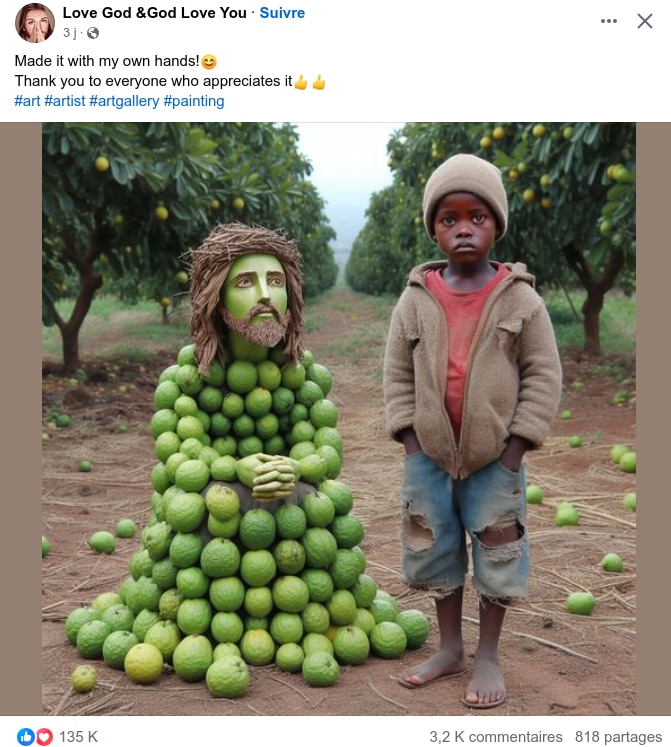On Facebook—the retirement home of social media—you’ll often stumble upon AI-generated images: children proudly displaying implausible art, women in rustic settings paired with captions like “Not even a hello, just because we work the fields,” or grandparents surrounded by armies of six-fingered grandchildren. Such visuals are the latest frontier of what might be called “boomer aesthetics,” already infamous for their kitschy creations—‘90s digital style at its finest, with steaming coffee mugs, gaudy comics, hearts, emoji garlands, and fonts of dubious taste.
When younger people see these images, they recoil in aesthetic disbelief: How could anyone think of sharing this? Are they even aware? Seriously, why?

This clash stems from a generational divide in how imagination functions, likely rooted in differing levels of cultural capital—a concept introduced by Pierre Bourdieu to describe the symbolic and cultural assets an individual amasses and shares within a social group. Younger generations, raised in a world saturated with visual stimuli, tend to possess a distinct form of digital cultural capital. This shapes their perception of images, making them view visuals not as mere representations of reality but as encoded cultural symbols. For them, visual elements carry meanings far beyond their literal content, acting as a kind of visual language. For those steeped in the hyper-saturated visual culture of the internet, images no longer reflect the world—they are inseparably part of it.
Drawing on Roland Barthes, we can distinguish between denotation—the direct, objective meaning of an image—and connotation, the secondary meaning loaded with cultural or emotional significance. For younger generations, images form part of their environment, with a weaker denotative value and a stronger connotative one. This shift in perception, compounded by the natural evolution of connotative meaning (and thus cultural references), has deepened the aesthetic divide.

Digital platforms’ affordances—the actions they enable for users—further encourage social bonds through shared symbols and signs. Social media supports the creation and spread of visual content like memes, which lack denotative functions but carry a strong connotative charge. These visuals rely on collective codes, both drawing on and generating cultural references that convey identity and belonging. They also create dense semiotic games with multiple layers of meaning.
The appearance of truth in the representation is enough to affirm its perceived authenticity, without the need for further verification.
Memes don’t seek to realistically depict the world; rather, they combine images, text, and context to craft and allude to meanings shared within specific communities. They act like ideograms, where their meaning comes not from what is depicted but from the referential system in which they are interpreted. The interpretive codes for these visuals emerge rapidly and fluidly within digital communities, making the ability to decode them a key skill in contemporary visual literacy.

Older generations—the “boomers”—raised in a pre-digital communicative environment, tend to approach images with a predominantly denotative mindset. Having limited exposure to the symbolic or ideogrammatic use of visuals, they are more likely to interpret images as direct representations of the real world. This trust is anchored in the perception of images as windows to reality, not as signs requiring interpretation.
This perspective persists even when an image’s truth-value is blatantly fabricated. A less practiced visual literacy, paired with a historical lack of questioning around the authenticity of images, leads boomers to easily fall for obviously AI-generated visuals. Ultimately, even for them, whether an image is true or false matters less to them than its emotional resonance and its function in building a sense of belonging. Unlike younger generations, however, boomers consistently treat images as if they were real. The truth takes a secondary role, but within a framework where its presence is still assumed.
For younger generations, images are ideograms—cultural and identity-building tools. For older generations, they are testimonies, serving similar cultural and identity-building roles but interpreted through a very different lens.

Canadian sociologist Erving Goffman described the “presentation of self”, a concept explaining how individuals act like performers in every social interaction, crafting a role to fit their audience. Goffman distinguished between the frontstage, where people project an image of themselves aligned with social expectations, and the backstage, where they can let down their guard and reveal their “true self.”
Unlike younger generations, boomers consistently treat images as if they were real. The truth takes a secondary role, but within a framework where its presence is still assumed.
In the digital age, the line between frontstage and backstage becomes increasingly blurred. Audiences are fluid, and messages intended for one social bubble often find their way into another. This dynamic creates linguistic and cultural interference: parents stumble across the cryptic memetics of their children, while younger generations encounter the unique visual language of their elders.

While boomers also use images to construct cultural identity, their references and the criteria by which they assign value differ significantly. Pseudo-realistic images—such as some AI-generated visuals—are often regarded as authentic because their realism is sufficient to evoke the historical connection between images and the real world. This creates a kind of “automatic trust” in realism: the appearance of truth in the representation is enough to affirm its perceived authenticity, without the need for further verification.
Even the ideogrammatic imagery favored by boomers has distinctive traits. Coffee mugs, retro comics, bold text in quirky fonts—all coalesce into a vintage or kitsch aesthetic steeped in nostalgia, reassurance, and traditional values. Yet it’s not merely the comforting ritual of the morning coffee that grounds the boomer amid the chaos of the digital infosphere. The deeper cause of this irreconcilable aesthetic divide lies in the way images are perceived to reclaim a role that is fading—or perhaps never fully existed: that of faithfully representing reality. A reality that, beyond being perpetually in flux, is now increasingly constructed from our overwhelming reserve of symbolic references.


